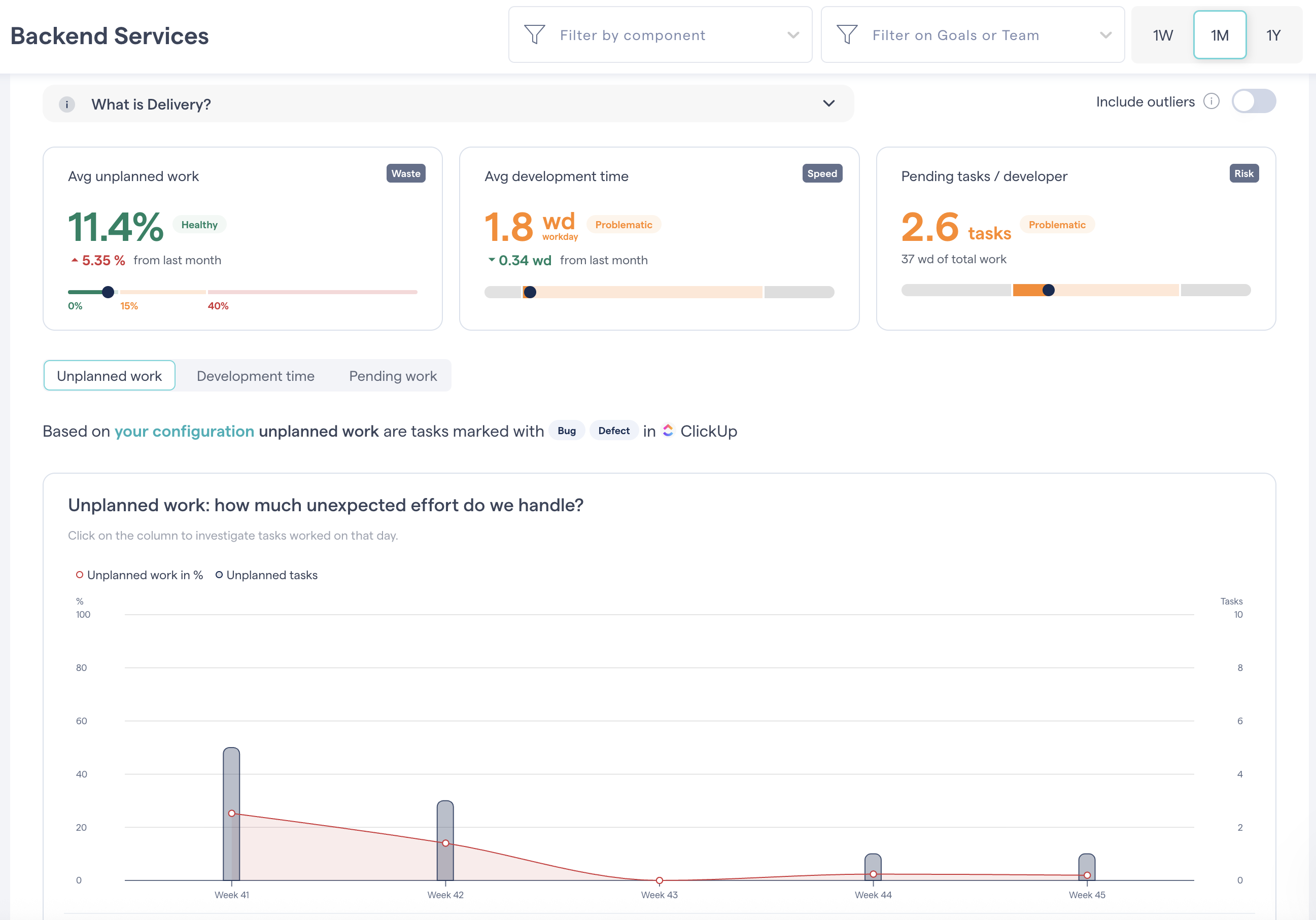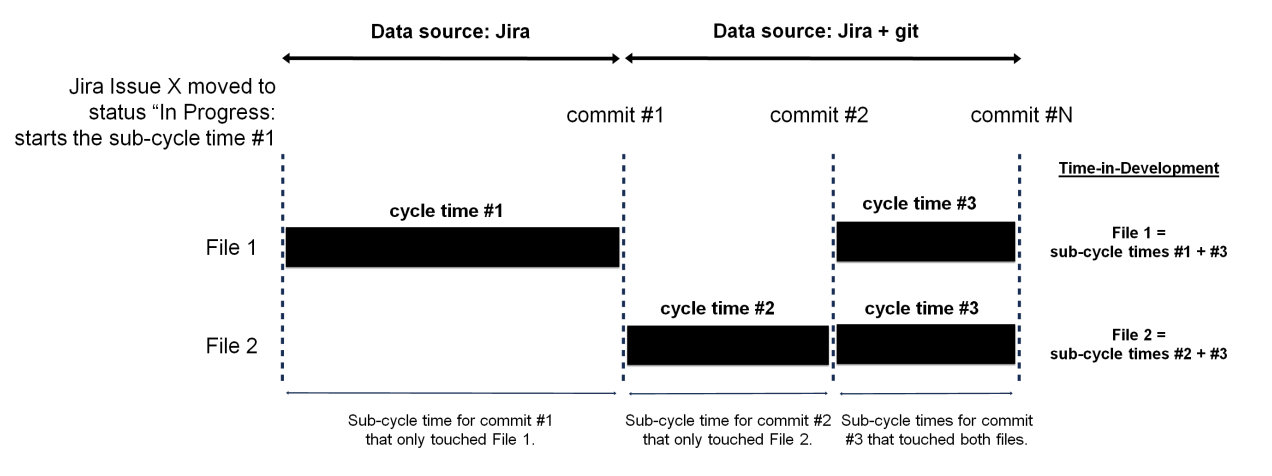Measure Development Outcomes: Waste, Development Speed & Risk¶
⚠ Attention: This document describes early access features. The new Delivery analysis is in Beta stage, and available for opt-in customers. Contact your CodeScene Account Executive to get early access.
Delivery shows how efficiently development work becomes finished code. It complements DORA (deploy/release) by focusing on the coding side of flow.
Use CodeScene’s Delivery analysis to track team/domain KPIs, spot bottlenecks, and tie delivery outcomes back to technical drivers (Code Health is the leading indicator; Delivery the lagging result).
Use the Delivery analysis to:
Track lead times and unplanned work/waste as outcome KPIs.
See pending work/WIP risk early before it hits production.
Spot bottlenecks in both coding and post-coding stages (reviews, QA, deployments).
Guide retrospectives and coaching: inspect trends and connect outcomes to technical and process drivers.
Connect Code Health to outcomes: are we getting faster and better?

Fig. 127 CodeScene’s Delivery view presents outcome-oriented KPIs and actionable trends.¶
Pre-requisites for CodeScene’s Delivery Analysis¶
Codescene automatically calculates development time for each task down to the file level. No manual tracking of time spent or estimates/guesses needed.
To enable the Delivery analysis, you need:
Trace tasks to commits. Use one of: * Smart commits with the task ID in the commit message, * Task ID encoded in the branch name, or * Task ID referenced in the PR/MR.
Enable PM integration to fetch task data (e.g., Jira, ClickUp). See Integrate Costs and Issues into CodeScene.
Delivery KPIs¶
The Delivery analysis presents three high-level KPIs and views: Unplanned Work (waste), Development Time (speed), and Pending Work per Developer (risk).
CodeScene’s Unplanned Work measures how much unexpected effort you handle¶

Fig. 128 CodeScene’s Unplanned Work measures how much unexpected effort you handle¶
Unplanned work represents tasks the team didn’t anticipate up front (e.g., production bugs, rework). You configure which task/issue types count as unplanned.
Measure: time_spent_on_unplanned_tasks / total_time_spent_on_all_tasks.
Unplanned work steals capacity and makes delivery unpredictable. Minimizing unplanned work is key to sustainable flow.
💡 The amount of Unplanned work indicates the unrealized potential that can be optimized in an organization. Less unplanned work reduces stress and increases predictability and throughput.
CodeScene’s Development Time measures how fast you implement tasks¶

Fig. 129 CodeScene’s Development Time measures how fast you implement the average task.¶
High-performing teams in healthy codebases ship small, frequent changes. Short development times improve time-to-market.
Measure: average lead time per task from In-Progress → last commit referencing the task.

Fig. 130 CodeScene automatically calculates the development time for each task down to the file level.¶
💡 Some tasks naturally take longer. Use the table below the charts to identify outliers and work needing attention.

Fig. 131 CodeScene highlights long-running tasks and highlights bottlenecks in both development and post-coding stages.¶
CodeScene’s Pending work measures the amount of work-in-progress¶

Fig. 132 CodeScene measures the amount of pending work in progress¶
Efficient delivery limits parallel work and ships small batches. Large tasks lengthen feedback loops and increase failure cost.
Measure: number of tasks per developer where coding has started but the task isn’t completed.
⚠ Limitation: In this version, pending work is identified on the main analysis branch only; work that exists only on feature branches isn’t detected. Future versions will include development branches.
💡 Reducing parallel work improves predictability and pace.
FAQ: Frequently Asked Questions on the Delivery Analysis¶
Can I break down my KPIs to the team-level or to specific domains/components/services?¶
Yes. Use filters to view delivery metrics by team and/or by domain. Define teams and architectural components in your project configuration to enable these filters.

Fig. 133 CodeScene let’s you filter the delivery metrics by team and/or by domain.¶
How can CodeScene’s calculate our Development Time for a task?¶
CodeScene pulls of this magic by combining data from your PM tool (e.g. Jira) with commit data from Git. For this to work, there has to be _some_ way for CodeScene to map tasks to commits.
💡 Typically, you’d use smart commits where the task ID is encoded in the commit message: git commit -m “MY-PROJ-756: adjust the font size in the customer legend”.
The metric measures cycle time from when a task moves In-Progress until the last commit that references that task.

Fig. 134 CodeScene automatically calculates the development time for each task down to the file level.¶
Can I define what unplanned work is in our context?¶
Yes. You have full control. By default, CodeScene treats “Bug/Defect” as unplanned. Change these rules in the PM Integration; see Integrate Costs and Issues into CodeScene.
What does it mean that Code Health is the leading indicator and Delivery the lagging result?¶
In our study on how The Business Impact of Code Health , we found that you develop features up to 10x faster in healthy code, and achive 15x fewer defects than unhealthy code.
Further, our model for translating Code Health improvements into speed and defect reduction lets you make a business case for code quality and technical debt remediations.
👉 TL;DR: Improvements in Code Health lead to business outcomes—faster, better. Code Health predicts; Delivery demonstrates.
Example: you refactor a low-health hotspot. Subsequent changes in that area become smaller and safer. Over several tasks, Delivery trends typically show shorter Development Time and less Unplanned Work—the measurable outcomes—plus the human ones: fewer fire drills, fewer production incidents, and less stress.